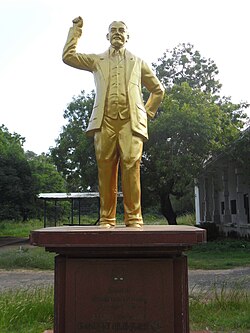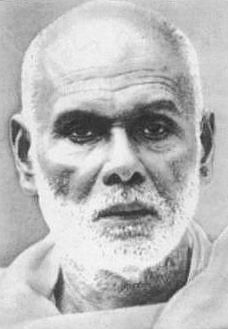Chempakaraman Pillai
Chempaka Raman Pillai | |
|---|---|
Indo-German Conspiracy |
Chempakaraman Pillai (alias Venkidi;[1] 15 September 1891 – 26 May 1934) was an Indian-born political activist and revolutionary.[2] Born in Thiruvananthapuram, to Tamil parents, he left for Europe as a youth, where he spent the rest of his active life as an Indian nationalist and revolutionary.[3]
Although his life was mired in controversies, including a squabble with Adolf Hitler,[4] information on his life in Europe was sketchy in the immediate years after his death. More information has come out in recent years.[1]
Chempakaraman Pillai is credited with the coining of the salutation and slogan "Jai Hind"[1] in the pre-independence days of India. The slogan is still widely used in India.
Chempaka Raman Pillai, who started the Indian National Voluntary Corps on 31 July 1914, was instrumental in inspiring Netaji Subhas Chandra Bose to start the Indian National Army (INA).[4]
Early life
Pillai was born into a
In Europe
Pillai attended
In October 1914, Pillai moved to Berlin and joined the
SMS Emden bombing of British Madras
On 22 September 1914, The
War activities
The Indian Independence Committee ultimately became involved in the
Many of Pillai's letters to A. Raman Pillai, then a student in the University of Göttingen, were kept by Raman Pillai's son Rosscote Krishna Pillai. The letters reveal some aspects of Pillai's life in Germany between 1914 and 1920, as does one of July 1914, calling upon Indian soldiers in the British Indian Army to rise in revolt and fight against the British.
After the end of World War I and Germany's defeat, Pillai stayed in Germany, working as a technician in a factory in Berlin; when Netaji Subhas Chandra Bose visited Vienna, Pillai met him and explained his plan of action.
Foreign Minister of Provisional Government of India

Pillai was the foreign minister of the
During this time, the Germans were helping the Indian revolutionaries from their own motives. Though the Indians made it clear to the Germans that they were equal partners in their fight against the common enemy, the Germans wanted to use the revolutionaries' propaganda work and military intelligence for their own purposes.[5]
In 1907, Pillai coined the term "Jai Hind",[6][7] which was adopted as a slogan of the Indian National Army in the 1940s at the suggestion of Abid Hasan.[8] After India's independence, it emerged as a national slogan.[9]
Marriage and death
In 1931, Pillai married Lakshmi Bai of
References
- ^ a b c d Indugopan, G.R. (27 September 2016). "Chempaka Raman Pillai: The freedom fighter who coined 'Jai Hind'". Onmanorama. Retrieved 7 October 2020.
- ^ a b c d Krishnan, Sairam (17 August 2016). "Did a Tamil man from Trivandrum mastermind the bombing of British Madras during World War I?". Scroll.in. Retrieved 7 October 2020.
- ISBN 978-8-189-00412-5.
- ^ a b "Chempaka Raman Pillai: The freedom fighter who coined 'Jai Hind'".
- ^ a b Liebau, Heike (2019). ""Unternehmungen und Aufwiegelungen": Das Berliner Indische Unabhängigkeitskomitee in den Akten des Politischen Archivs des Auswärtigen Amts (1914–1920)". MIDA Archival Reflexicon: 2–4.
- ISBN 978-1-84383-518-9.
...Champakaraman Pillai, a committed anti-imperialist. He is credited with coining the phrase 'Jai Hind' meaning 'Victory for India'...
- ^ Saroja Sundararajan (1997). Madras Presidency in pre-Gandhian era: a historical perspective, 1884-1915. Lalitha Publications. p. 535.
To Champakaraman Pillai goes the credit of coining the taraka mantra "Jai Hind" in 1907...
- ^ Gurbachan Singh Mangat (1986). The Tiger Strikes: An Unwritten Chapter of Netaji's Life History. Gagan Publishers. p. 95.
- ISBN 978-1-108-47203-6.
- ^ Rose, N. Daniel (4 December 2007). "A Forgotten Fighter". The New Indian Express. Chennai. Archived from the original on 12 March 2017. Retrieved 4 September 2018.
External links
- Asghar Ali Engineer (2006). They Too Fought for India's Freedom: The Role of Minorities. Hope India Publications. ISBN 81-7871-091-9. Retrieved 8 November 2014.
- Heike Liebau: "„Unternehmungen und Aufwiegelungen“: Das Berliner Indische Unabhängigkeitskomitee in den Akten des Politischen Archivs des Auswärtigen Amts (1914–1920)." In: MIDA Archival Reflexicon (2019), ISSN 2628-5029, 1–11.


